




Lighting-control systems based on the DALI protocol are illuminating workplaces around the world, as several projects shortlisted for the 2020 DALI Lighting Awards demonstrate.
October 1, 2021
 Today more than ever, workplaces require innovative, effective, intelligent lighting-control solutions to keep staff safe, healthy and comfortable, while simultaneously conserving energy. Increasingly dynamic use of workplaces is becoming the norm, where trends such as ‘hot desking’ require automatic illumination adjustment in line with the personal preferences of occupants.
Today more than ever, workplaces require innovative, effective, intelligent lighting-control solutions to keep staff safe, healthy and comfortable, while simultaneously conserving energy. Increasingly dynamic use of workplaces is becoming the norm, where trends such as ‘hot desking’ require automatic illumination adjustment in line with the personal preferences of occupants.
In addition, different office areas require more and clearer delineation, coupled with lighting-based directions for people moving around the building. And to help impart infection control as part of the ‘new normal’, offices need more touch-free devices to control lighting, enabled by smart technologies like occupancy sensors and/or wireless control.
There is growing recognition of the effects that a comfortable and technically competent working environment has on staff wellbeing and productivity. Significant importance is attached to selecting the optimum lighting-control system. For this reason, among others, many workplace projects are specifying lighting control based on the DALI protocol. A number of these projects were shortlisted for the 2020 DALI Lighting Awards.
| >> View the Winners of the 2020 DALI Lighting Awards |
| >> Submit your project for the DALI Lighting Awards 2021 |
1 Time Square
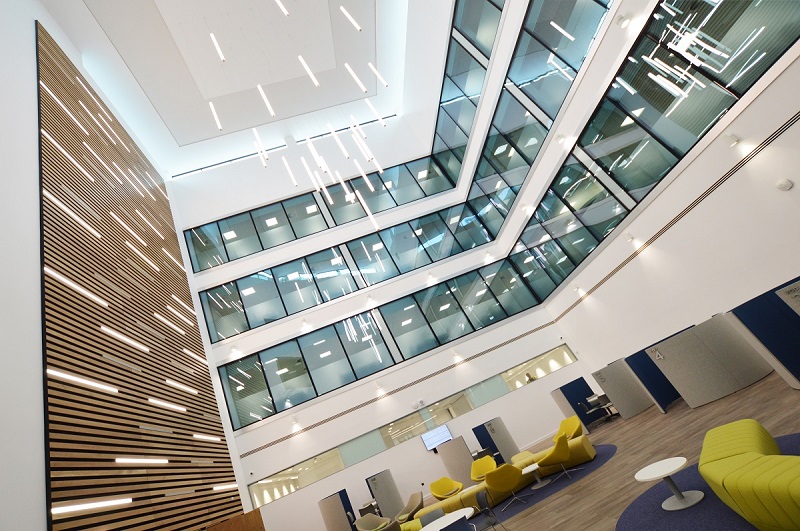 A case in point was 1 Time Square, a three-building office complex that serves as the new headquarters of the borough council in Warrington, UK. Osram provided the lighting-control technology, opting for its Encelium light-management system, along with compact and linear DALI LED drivers and DALI sensors.
A case in point was 1 Time Square, a three-building office complex that serves as the new headquarters of the borough council in Warrington, UK. Osram provided the lighting-control technology, opting for its Encelium light-management system, along with compact and linear DALI LED drivers and DALI sensors.
All luminaires at the office complex use DALI, amounting to over 2,000 in total. The project, which was shortlisted in the large indoor category (more than 500 luminaires) at the 2020 DALI Lighting Awards, also benefits from 400 passive infrared sensors.
DALI’s ability to access and monitor the system remotely – and facilitate easy modifications – proved important in its selection. Moreover, using DALI-certified products throughout the three buildings enabled all stakeholders to co-ordinate their tasks with maximum levels of compatibility. Thanks to this unifying standard, connecting a mix of products from different manufacturers proved straightforward, thus saving considerable amounts of time and money. Additionally, working with DALI-certified technologies means that the entire lighting installation at 1 Time Square is future-proof.
China Mobile
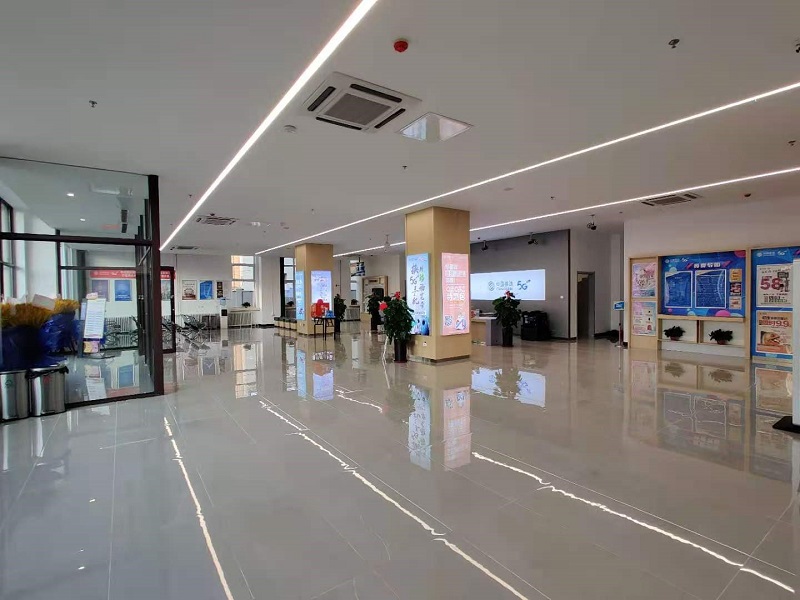 Shortlisted in the same Award category was the 10-floor Shenyang Xiwa Yao office building for China Mobile. Here, the requirement for smart lighting was not only to deliver the benefits of a better working environment for employees, but also to save energy costs.
Shortlisted in the same Award category was the 10-floor Shenyang Xiwa Yao office building for China Mobile. Here, the requirement for smart lighting was not only to deliver the benefits of a better working environment for employees, but also to save energy costs.
Lighting design specialist Liaoning Zhongke Huanyi Lighting Equipment Technology Co., Ltd specified DALI across an area covering 10,478 sq.m, encompassing the open office area, business hall, meeting room, fitness area, restaurant, and underground garage. Demonstrating the advantages of intelligent lighting control, the project uses more than one thousand DALI DT6 LED drivers for dimming, over 200 DALI multi-sensors for daylight and presence-dependent lighting control across separate lighting zones, 17 DALI switch panels for recalling scenes manually, and 45 DALI power supplies.
The easy-to-adjust DALI system in place at the China Mobile office building makes secondary planning easy and flexible when space functions are changed, while the common DALI protocol makes it straightforward to add or replace devices at a later date.
Commonwealth ATP
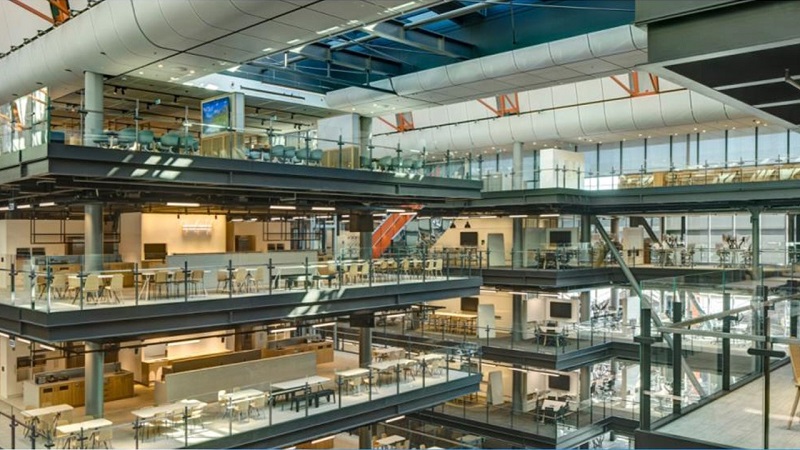 Further south, the Commonwealth ATP (Australian Technology Park) in Sydney, Australia, was another large indoor project shortlisted for the DALI Lighting Awards. The installation, with a control system from Signify Philips Dynalite, extends over two buildings with a total of 12 levels, covering 93,164 sq.m and housing 11,646 occupants.
Further south, the Commonwealth ATP (Australian Technology Park) in Sydney, Australia, was another large indoor project shortlisted for the DALI Lighting Awards. The installation, with a control system from Signify Philips Dynalite, extends over two buildings with a total of 12 levels, covering 93,164 sq.m and housing 11,646 occupants.
Some 3,200 multi-function sensors perform occupancy detection and, when triggered, provide contrast balancing for optimal work conditions while simultaneously delivering energy efficiency. Working seamlessly alongside the DALI luminaires are 3,000 emergency DALI fittings. The same DALI bus that serves the day-to-day lighting performs the emergency driver tests; the system shares the results with the BMS via BACnet and OPC.
Only DALI could provide sufficient flexibility for both the installation and ongoing operation of the system. This factor was paramount as the client did not want to endure a new rewiring project after every internal team reassignment.
Dickson Interchange Project
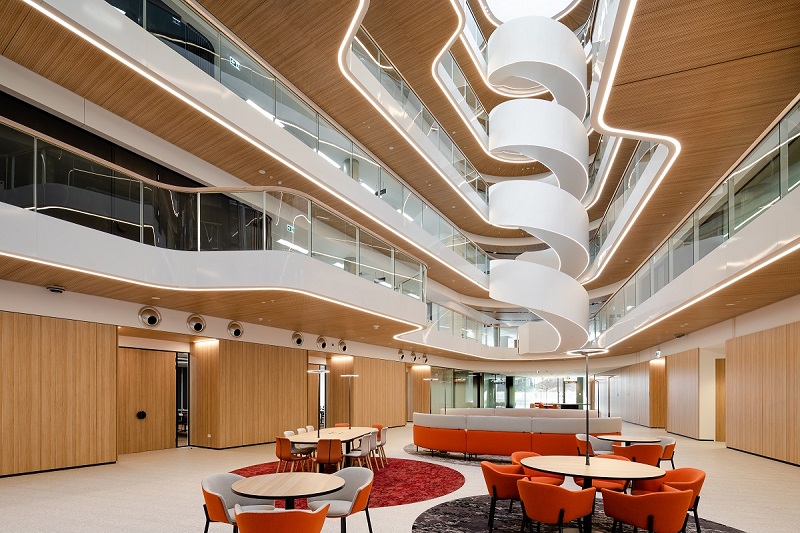 Remaining in Australia, the Dickson Interchange Project (DIP) was yet another large indoor project that made the shortlist for the Awards. DIP is set to be the home of the ACT (Australian Capital Territory) Planning and Land Authority government department.
Remaining in Australia, the Dickson Interchange Project (DIP) was yet another large indoor project that made the shortlist for the Awards. DIP is set to be the home of the ACT (Australian Capital Territory) Planning and Land Authority government department.
The DALI-2 lighting control system from zencontrol played an integral role in meeting the project’s objectives by enabling complete monitoring and control of the building’s lighting and emergency lighting systems. Energy savings accrue thanks to daylight harvesting throughout the tenancy floors, as well as timed control of open-plan areas to optimise the lighting for building occupants.
Over 4,400 DALI and DALI-2 compliant luminaires now feature, predominantly with Tridonic LCA DALI-2 LED drivers. The lighting-control system comprises around 87 DALI-2 application controllers linked via a TCP/IP Ethernet-based building services network. Furthermore, the system uses 634 DALI-2 PIR sensors and 147 DALI-2 certified input modules and scene plates, while DT8 control modules control colour changing (via RGBW lighting) in select areas of the building. Image courtesy of Rodrigo Vargas.
Ramboll headquarters
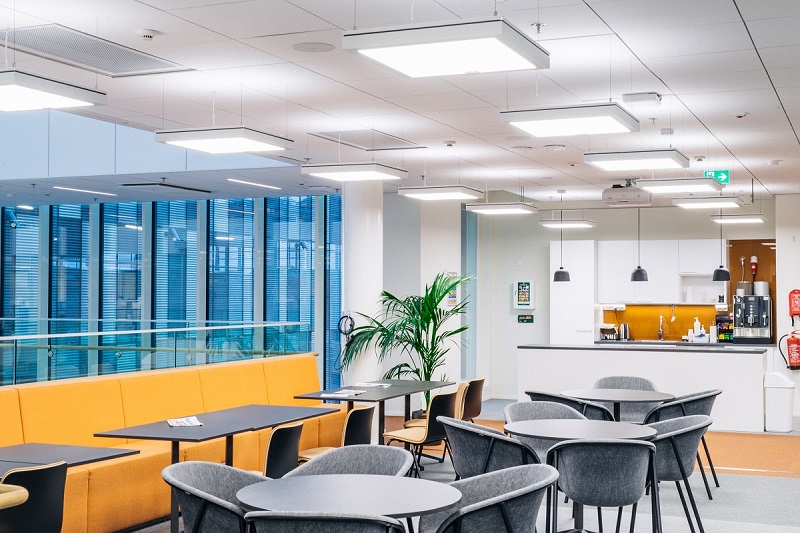 DALI is of course suitable across a range of project sizes, from small to large. Shortlisted for the medium indoor project award category (65 to 500 luminaires) was the office headquarters of Ramboll in Espoo, Finland. Ramboll appointed Helvar to create a smart and adaptable lighting-control solution that would also collect data about building usage.
DALI is of course suitable across a range of project sizes, from small to large. Shortlisted for the medium indoor project award category (65 to 500 luminaires) was the office headquarters of Ramboll in Espoo, Finland. Ramboll appointed Helvar to create a smart and adaptable lighting-control solution that would also collect data about building usage.
The Imagine router installation at Ramboll – with close to 350 luminaires, multifunctional sensors, relays and control panels – comprises subnetworks served by 16 individual DALI routers. Imagine is a networked lighting-management solution based on open standards (such as DALI, Ethernet and Rest APIs), making for easy integration with building management systems and cloud services.
Daylight harvesting also features, so Ramboll saves energy on sunny days. PIR sensors and ceiling multi-sensors monitor occupancy and daylight levels, ensuring that luminaires only activate when required. Ultimately, the DALI Helvar router solution was the perfect choice, as the solution is scalable, flexible, and perfectly designed to integrate seamlessly with other building management systems.
Conclusion
As part of the ‘new normal’, encouraging people back into offices means demonstrating that they are safe, healthy, and environmentally responsible places. Here, suitably specified lighting control can make a huge difference, as these projects ably demonstrate.
| >> View the Winners of the 2020 DALI Lighting Awards |
| >> Submit your project for the DALI Lighting Awards 2021 |
